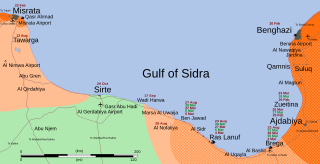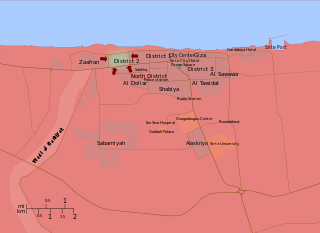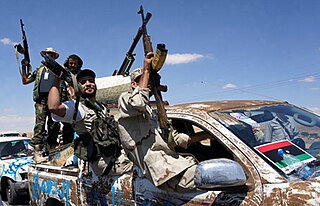
Sabha is one of the districts of Libya. It is located near the center of the country, in the Fezzan region. The capital is the city of Sabha. Sabha District borders the following districts, namely, Wadi Al Shatii in the north, Al Jufrah in the east, Murzuq in the south and Wadi Al Hayaa in the west.

Fezzan is the southwestern region of modern Libya. It is largely desert, but broken by mountains, uplands, and dry river valleys (wadis) in the north, where oases enable ancient towns and villages to survive deep in the otherwise inhospitable Sahara Desert. The term originally applied to the land beyond the coastal strip of Africa proconsularis, including the Nafusa and extending west of modern Libya over Ouargla and Illizi. As these Berber areas came to be associated with the regions of Tripoli, Cirta or Algiers, the name was increasingly applied to the arid areas south of Tripolitania. Fezzan is Libya’s poorest region.

Mizda was one of the districts of Libya. In the 2007 reorganization of Libyan districts its territory became part of Jabal al Gharbi District.
There have been no operational railways in Libya since 1965, but various lines existed in the past. An extensive system is now being developed and under construction.

The Libyan Civil War began on 17 February 2011 as a civil protest and later evolved into a widespread uprising. By mid-August, anti-Gaddafi forces effectively supported by a NATO-led international coalition were ascendant in Tripolitania, breaking out of the restive Nafusa Mountains in the south to mount an offensive toward the coast and advancing from Misrata on loyalist-held cities and villages from the north and east.

The First Gulf of Sidra offensive was the second major rebel offensive of the Libyan Civil War. It was mounted by anti-Gaddafi forces immediately after their victory in the Battle of Ajdabiya. The offensive was meant to have the rebel forces quickly reach Gaddafi's hometown of Sirte.
The Fezzan campaign was a military campaign conducted by the National Liberation Army to take control of southwestern Libya during the Libyan Civil War. During April to June 2011, anti-Gaddafi forces gained control of most of the eastern part of the southern desert region during the Cyrenaican desert campaign. In July, Qatrun changed to anti-Gaddafi control on 17 July and back to pro-Gaddafi control on 23 July. In late August, anti- and pro-Gaddafi forces struggled for control of Sabha.
The Battle of Tawergha was a military engagement of the Libyan Civil War that began on 11 August 2011 when anti-Gaddafi forces based in Misrata advanced southeast along the road to Sirte in the early morning and attacked Libyan Army positions in the town of Tawergha. It ended on 13 August when rebel troops, after capturing the town, cleared it of snipers and artillery positions threatening Misrata.

The Second Gulf of Sidra offensive was a military operation in the Libyan Civil War conducted by rebel anti-Gaddafi forces in August and September 2011 to take control of towns along the Gulf of Sidra in an effort to surround Muammar Gaddafi's hometown of Sirte, which was held by pro-Gaddafi forces. It ended on 20 October, when Muammar Gaddafi and his son Mutassim Gaddafi were killed along with former defense minister, Abu-Bakr Yunis Jabr. The Gaddafi loyalists in the area were finally defeated when NTC fighters captured Sirte.
The raid onRa's Lanuf was a hit-and-run attack carried out in the early morning of 12 September 2011 by two groups of fighters loyal to Muammar Gaddafi in an apparently coordinated effort to disrupt oil refinery and export operations in the National Transitional Council-administered port town of Ra's Lanuf, Libya, during the Libyan Civil War.

The Battle of Sirte was the final battle of the Libyan Civil War, beginning when the National Liberation Army attacked the last remnants of the Libyan army still loyal to Muammar Gaddafi in his hometown and designated capital of Sirte, on the Gulf of Sidra. As of September 2011, Sirte and Bani Walid were the last strongholds of Gaddafi loyalists and the NTC hoped that the fall of Sirte would bring the war to an end. The battle and its aftermath marked the final collapse of the four-decade Gaddafi regime. Both Gaddafi and his son, Mutassim, were wounded and captured, and tortured and killed in custody less than an hour later. The month-long battle left Sirte almost completely in ruins, with many buildings damaged or totally destroyed.

The Battle of Bani Walid was a military operation in the Libyan Civil War conducted by anti-Gaddafi forces in September and October 2011, in an effort to take control of the desert city of Bani Walid from pro-Gaddafi forces. It began following days of force buildup on the part of the attackers, as well as skirmishes around the city.

The Second Libyan Civil War is an ongoing conflict among rival factions seeking control of the territory and oil of Libya. The conflict at the beginning was mostly between the House of Representatives (HoR) government that was controversially elected in 2014, also known as the "Tobruk government"; and the rival General National Congress (GNC) government, also called the "National Salvation Government", based in the capital Tripoli, established after Operation Odyssey Dawn and the failed military coup.
Ahmar or Al Ahmar (الاحمر) may refer to:

The Islamic State of Iraq and the Levant is a militant Islamist group active in Libya under three branches: Fezzan Province in the desert south, Cyrenaica Province in the east, and Tripolitania Province in the west. The branches were formed on 13 November 2014, following pledges of allegiance to ISIL leader Abu Bakr al-Baghdadi by militants in Libya.
This is a detailed timeline of the Libyan Civil War (2014–present).

The Battle of Sirte (2016) refers to the battle that started in the spring of 2016, in the region of Sirte, Libya, between the Islamic State of Iraq and the Levant (ISIL) and the forces of the Government of National Accord (GNA) backed by United States of America. ISIL forces had captured Sirte one year earlier, during the previous battle. The conflict for Sirte was described as ISIL's "last stand" in Libya.

Since November 2015, the United States and allies have carried out a large series of both airstrikes and drone strikes to assist Libya in its revived conflict in support of the Tripoli-based Government of National Accord against the ISIL presence in the region.

















